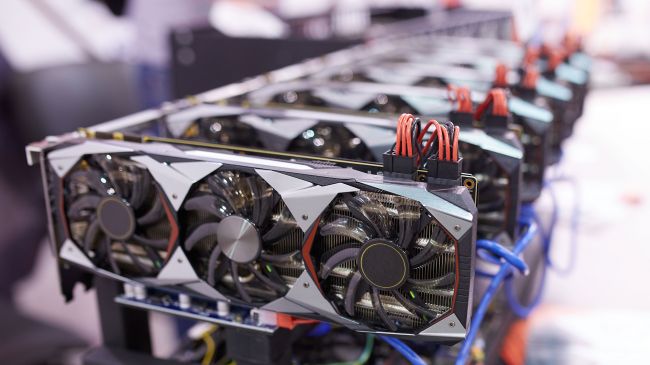
at PC Gamer are less worried about whether Nvidia, AMD, or Intel make lots of money and are a sound investment, and more interested in getting increasingly powerful computers to run increasingly impressive games. The question for us is, what would happen to Nvidia and AMD if cryptocurrencies suddenly disappeared as a revenue source? Will GPUs suddenly become affordable—and even if cryptos don’t crash, when will we have reasonably priced graphics cards again?
As to the latter, it’s difficult to say. Usually the mining craze only lasts 1-2 months at most, after which prices trend back toward MSRP, but we’re already well past that point this round. I keep hoping we’ve reached the point where demand will subside, but a quick look at Newegg indicates we’re not there yet, at all. Sigh. And even if mining becomes unprofitable, it could take a month or more before supply starts to catch up to the pent-up demand.

Even predicting the collapse of cryptocurrencies itself is a bold step. Love it or hate it, Bitcoin has been around for nine years now, and more cryptos are being created every week. After the collapse of Bitcoin in 2011, and then again in 2014, calling this latest bubble and burst the end seems extremely premature. Cryptocurrencies can be volatile, sure, with some pointing to the ascension of cryptos and others looking for their death. I wouldn't bet on either extreme. But let's say cryptos do go the way of the dodo. What does that mean for Nvidia and AMD? Probably not much in the long term.
AMD has weathered a lot of difficulties over the decades the company has been around, and it's currently in the black and providing some much-needed competition to Intel on the CPU side and Nvidia on the GPU side. AMD sold pretty much every high-end GPU it produced during the past year, and that's good for the company's bottom line, but it's not like AMD could double the price per GPU just because demand was high—that was mostly the retailers and AMD's partners, as there are contracts for set prices on the actual GPUs
Nvidia, who leads in overall GPU sales, mining is even less of a factor. Nvidia also sold every GPU it could manufacture, and it has even more markets for GPUs besides gaming and mining. Machine learning, AI research, and the datacenter have been major growth areas over the past several years, and the ORNL Summit supercomputer is slated to use 27,600 Tesla V100 GPUs. That might not seem like a lot compared to the millions of GPUs being sold to gamers and/or miners, but each Tesla V100 costs many times more than even the fastest GeForce card—roughly $15,000 based off the $149,000 price of the DGX-1 servers. One supercomputer like Summit can mean more revenue than a couple of million gamers, and Summit is only one of many supercomputers that will use Nvidia GPUs.
Currently, 120 of the top 500 supercomputers in the world use some form of Nvidia GPU, and that number is expected to increase over the next year. Nvidia has devoted a relatively large chunk of the GV100 GPU to the new Tensor cores, which offer almost an order of magnitude more computational power than the previous generation parts. Those Tensor cores aren’t going to be used for graphics work any time soon. AMD wants to get in on the supercomputer and machine learning markets as well, with its Radeon Instinct line. AMD demonstrated a 1 PFLOP/s rack using 80 Radeon Instinct MI25 cards last year at SIGGRAPH. AMD's GPUs might be a no-show in the Top500 list right now, but that could easily change.
Outside of supercomputers, GPUs are proving useful for other work as well. Self-driving cars are something Nvidia has been working toward for several years, and GPU compute has been gaining traction since the early aughts. OpenCL and CUDA are specifically designed around enabling GPUs to do things besides graphics work—and they're at the heart of all the mining algorithms running on GPUs. In the past, we've seen things like SETI@Home and Folding@Home leverage GPU compute, and now there are companies looking to enable machine learning research via distributed computing platforms. That's a bit of a scary thought, and not just because of the Skynet potential—if distributed machine learning takes off and becomes something businesses are willing to pay for, it could easily overtake cryptocurrency mining as a source of revenue. “Sorry guys, I can’t play games right now. My graphics card is busy training data sets and I get $10 per day for it!”
Because of these factors, with or without cryptocurrency mining, I don't see the thirst for GPUs slaking off any time soon. It might drop back to more reasonable levels, so that a GTX 1070 only costs $350-$400 again, but I don't expect a deluge of used GPUs to hit the market. Even if the estimate of around five million graphics cards going into mining service during the past quarter is correct, at a cost of $400 each, that's 'only' two billion dollars in GPUs, give or take. Over the past year, the total value of all cryptocurrencies went from around $17 billion to over $420 billion at present. Someone has to be holding onto all those Bitcoins and other cryptocoins, which explains how people were able to rent a 747 to ship graphics cards.

If the cards in use by the biggest miners are paid for by previous profits, that means there will be no rush sell old hardware. As long as the cards cost less in power to run than they earn from mining, they'll keep chugging along. That's why even now, AMD's HD 7950—that's a $330 card from 2012!—still costs over $150 on eBay. Prior to the mining boom, you'd typically see a top-tier GPU from three years before sell for one third of its original price. Now it’s half the original value after nearly six years. Not that I'd recommend buying a used graphics card these days (though if you have some old GPUs around, you might consider trying to sell them while the getting is good).
In short, the GPU market will continue to see high demand for the foreseeable future. Cryptocurrencies may or may not be a factor in the coming years, but there are other areas that could become even more important. Moore's Law is basically dead on the CPU side of things, but scaling of performance in GPUs is alive and well. Nvidia has been posting record profits for several years running, and we should see either Volta, Ampere, and/or Turing products in the coming year. AMD's Computing and Graphics business is also alive and kicking, with RX Vega M going into Intel CPUs, Ryzen APUs recently launched, and second generation Ryzen coming soon.
There's no immediate cause for concern for either company, even if cryptocurrencies suddenly vaporized. Which wouldn't necessarily be a bad thing, as there are millions of gamers that would love to buy a reasonably priced graphics card.
Hi! I am a robot. I just upvoted you! I found similar content that readers might be interested in:
https://www.pcgamer.com/what-the-fallout-of-a-cryptocurrency-collapse-might-mean-for-graphics-cards/
Downvoting a post can decrease pending rewards and make it less visible. Common reasons:
Submit